MooN
Tour Pro
Somme 2014
Where to start ?
I’ll assume you know at least the general outline of the 1st world war & try not to sound like a high school history teacher...
Oneof the major allied offensives of the1st war took place in the Somme region of france in the spring of 1916, many,many soldiers died on both sides. Today there are the cemetery’s and memorials that one can visit, some of the battlefields are still visible 100 years later & there are a couple of museums, in order to explain what happened.
I have wanted for some time to visit some of these sites, partly for the historical interest, partly to pay my respects & partly as some sort of« devoir de memoire » I had the opportunity to grab a couple of days off work so took it & organised a week end trip. The main area of offensive, for British & commonwealth troops was on a 45km front between Peronne, Albert et Bapaume. This is only 300 odd kms from me so an easy afternoon run, but I wanted to have a complete day to visit so I planned to ride up on the Friday, visit on the Saturday & ride home on the Sunday.
Having decided that I didn’t want to do this with a « group of mates » it was either alone or with "A.N.other". A mate of mine (Stephane) was keen to come & able to get away (depite a 3 month old baby at home !)& he rides a knacked out old gpz 500. We also both live in the same world, morally & financially so we understand one another pretty well.
This is how it went...
Steph turned up at mine just before 11 on Friday, skies were clear blue & forcast was good for the whole week end but temps were down to around 13°c so it was liners in & off we went. A quick blast up the autoroute as far as Nemours where we stopped for lunch, & holiday mode was definately kicking in as we both wound down & started to profit from the ride, the sunshine (& the lack of kids...)
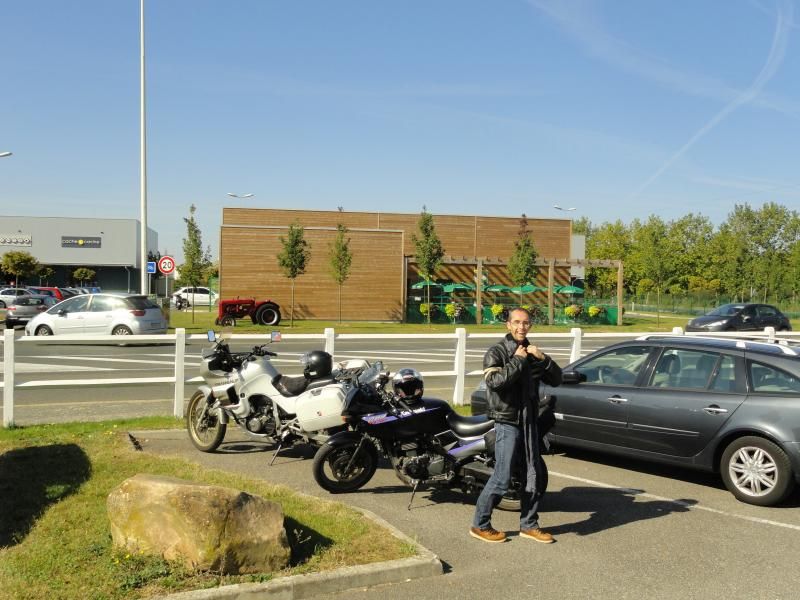
After lunch it was time to strip out the liners & hit the route nationale through Fontainebleau forest, Melun & on to Meaux. North of Meaux we got stuck behind a pair of ... I haven’t a clue what they’re called... machines for harvesting beetroot, or possibly sugarbeet? At one point I counted 15 cars, 9 trucks & 3 campervans, + us stuck behind the bloody things! & of course it was just the one section of road that’s narrow a winds around a lake & the "mer de sable" http://www.merdesable.fr/en
I managed to get ridiculously lost around Senlis (I don’t have satnav by the way) I knew I was heading North ish, which was right but i was sure I’d missed the road I wanted & had gone too far west before turning north. For some reason in this part of france the road numbers are not marked on the signposts, I knew I was looking for the town of Estrées but when there was a choice of “Estrées la chapelle” & “estrées summat else” I picked the wrong one...
We stopped further down the line & a quick check of the map soon had us back on course, though rather later than Ihad originally planned. I wish I’d had a go pro for the last bit, from the main road through Cappy & along the Somme valley to the B& B at Curlu... dusk was falling & it was superbly pretty but the road got worse & worse & smaller & smaller & we had to literally lean the bikes into a hedge to let the school bus come through, I swear I could hear Steph cursing the bloody transalp & regretting he’d ever agreed to follow me...
We eventually found the place, showered & had a passable pizza at the restaurant in the village which had a very bizarre billiard table.
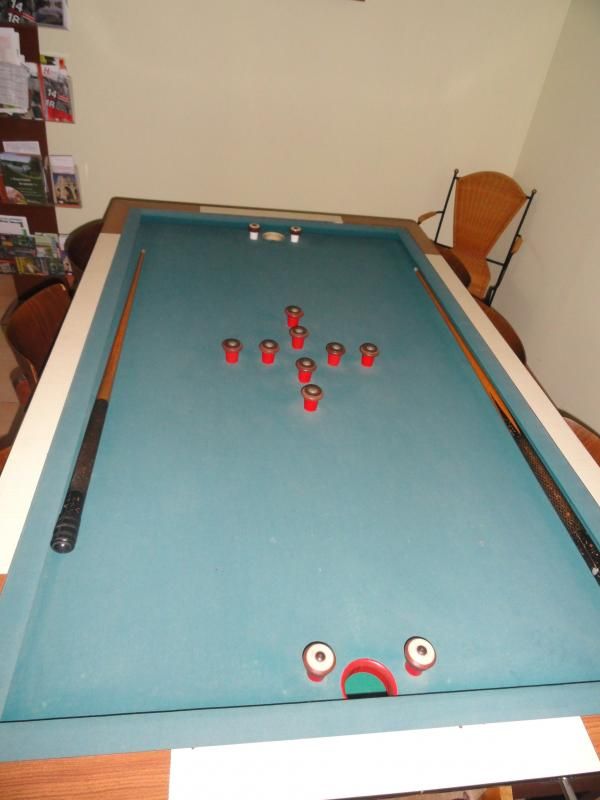
friday's route
http://goo.gl/maps/1H5sa
Saturday. Up & breakfast in time to be at the museum in Peronne for 10 ,when it opens. I had no idea how much time we’d want to spend here so we decided to just play it by ear.
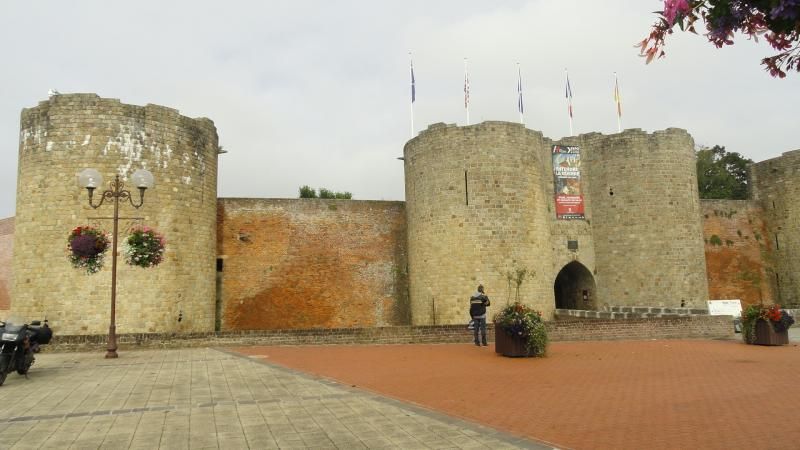
It was very good, there is sufficient stuff to occupy an avid history student, but laid out in a way that allows a more casual visitor to just browse through the main exhibits, filtering out the “boring” bits. We lost track of time a spent nearly 2 hours in there.
If "I" means infantry, then this was probably the first "I phone"...

so I had to get a photo of a phone taking a photo of a phone
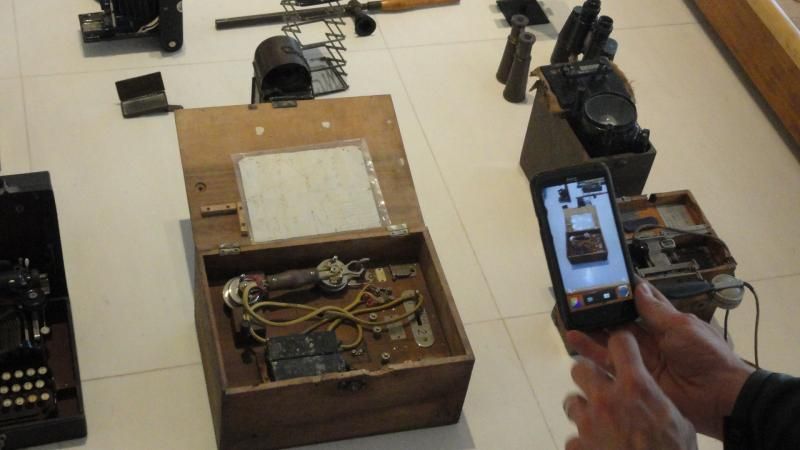
there is still stuff dug up almost everyday in the area, this lot is awaiting cleaning & classifying...
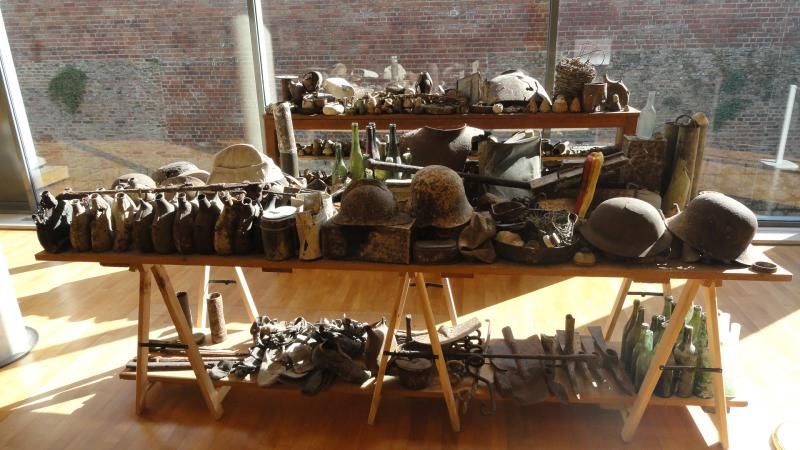
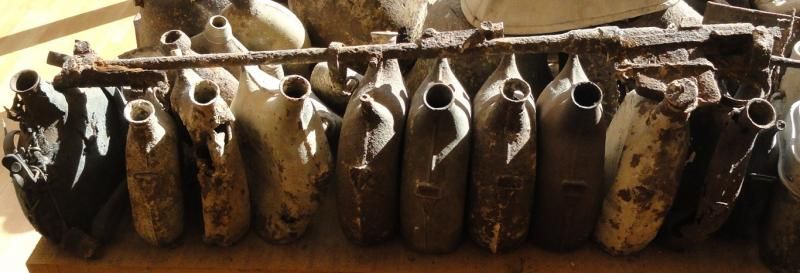
Lunch in Peronne!
chicken gizzard salad! Yum!

Then on to Rancourt. This was an obvious stop as there are 3 cemetery’s; Brit, German & French.
The brit cemetery here is a smaller one & I planned to visit & couple of larger ones so we visited the French & German ones here. The taking of the village of Rancourt by the French 32nd army corps on 25th September 1916 was decisive, as it marked the rupture of the enemies principal lines of communication. 3223 french soldiers lie here. Across the road are 11422 German.

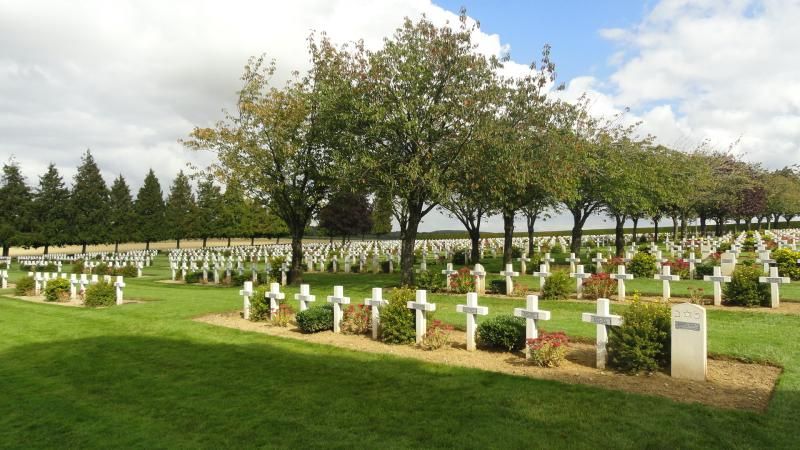
Interesting way of restraining the flag with a black band, like a sort of permanent "half mast"
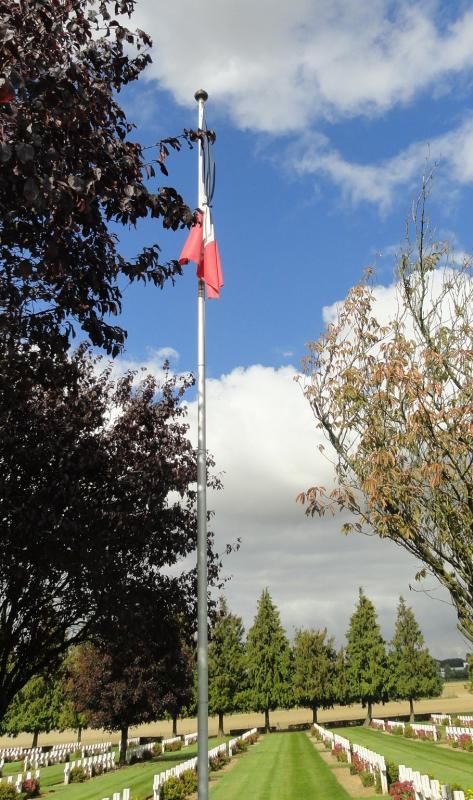
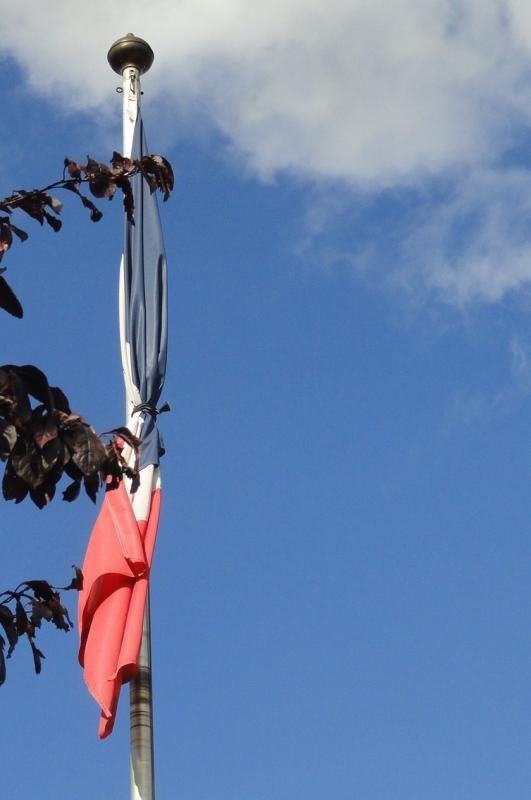
We then rode up the D20 to Longueval &“Delville wood” where the South African monument stands.
In Delville wood, 3 batallions of the SouthAfrican infantry (1st brigade I think) fought continuosly for 6 days,took & held the wood. Delville wood was about 1 km Square. On the 14thJuly when The 1st brigade launched their attack on the wood, thebrigade was composed of 123 officers with 3032 NCO’s & soldiers. On the 20thJuly, when they were relieved, there remained 19 officers & 600 men.
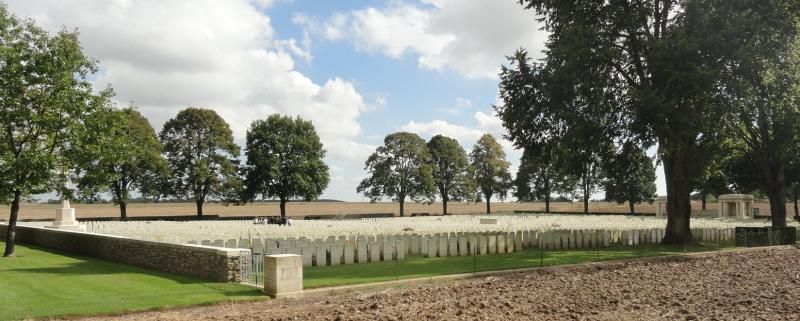
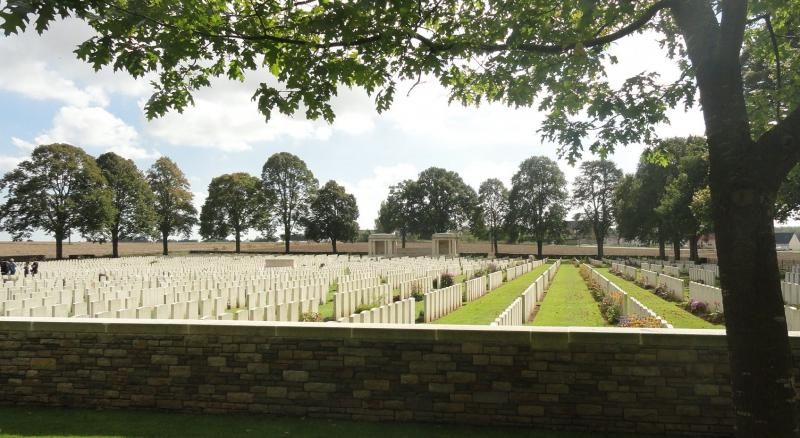
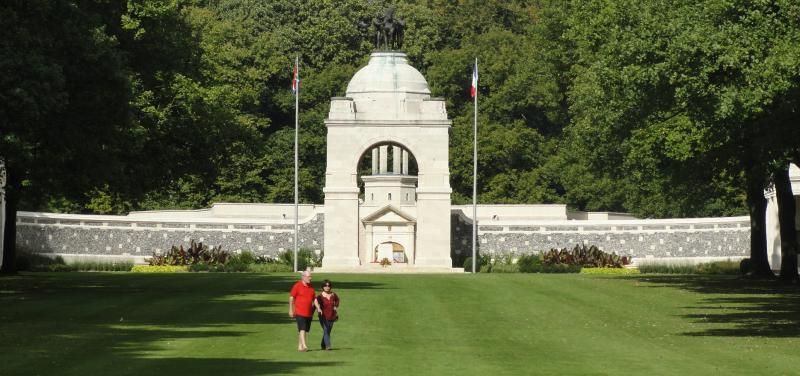
From delville wood we rode on to LochnagerCrater at La Boiselle
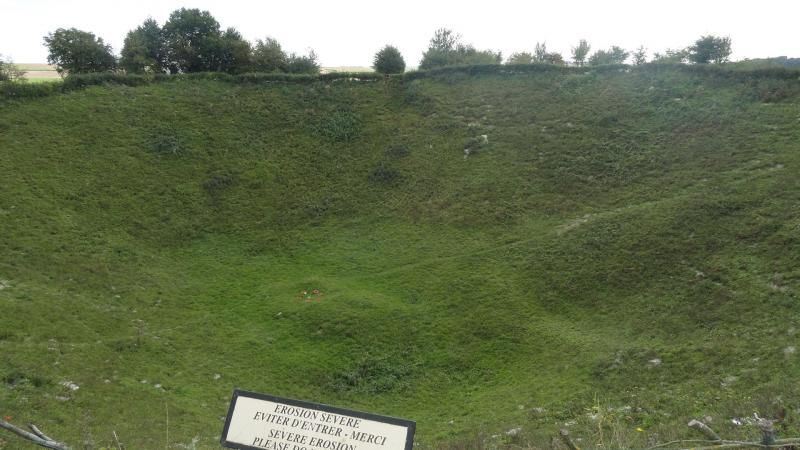
Despite being a “big hole in the ground”this was almost more moving than the cemeterys, not quite sure why. the thought of the men who dug the tunnels& the conditions they must have worked in? ( read "Birdsong" by Sebastien Faulks) the fact that this “hole” iswhat launched the bloodiest day in the history of the british army? There were3 of these mines, designed to destroy the german wire & front linetrenches. They were set off at 07h27 on the 1st July 1916, at 07h30the whistles blew & the British army went “over the top”...
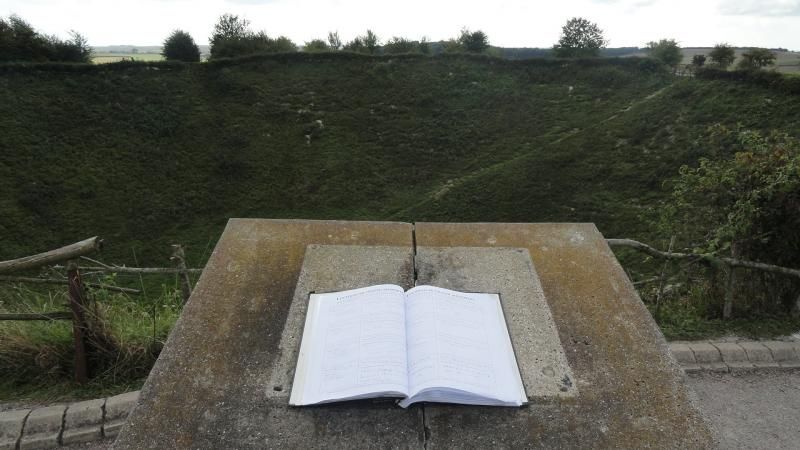
The high command was sure the mines wouldhave destroyed the German defences, the order was therefore, to “march” forward.The men climbed the trench ladders & formed up into their lines, they thenbegan to advance at walking pace. It is thought that the Germans were aware ofthe attack, had moved their men back until after the mines exploded & thenregained their positions. Whatever the reasons were, they were ready &opened up with machinegun fire “daisycutting” (a steady sweeping crossfire atknee height) from a number of positions. 60,000 men were either dead, injuredor missing by the end of the day.
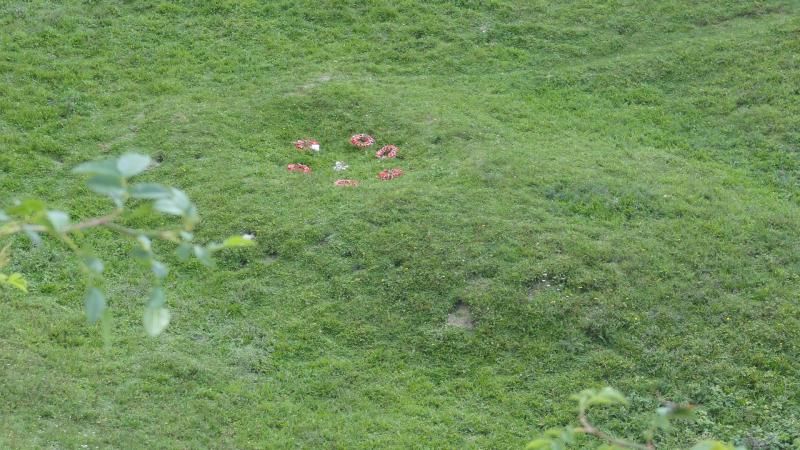
There is a bench on the edge of the crater on the back of which is noted " donated by friends who visit. In memory of friends who remain"
On to Pozieres, where tanks made their world début, 32 MK1 British tanks took to the battlefield here. 9 of them survived. We didn’t really stop here cos I wanted to get on to Thiepval, so on we went.
The Thiepval monument is impressive & powerful. 16 columns, each column has 4 faces, on each face are engraved the names of the missing from the British & South African armies from 1915 to 1918. “without distinction of rank,religion or social standing”
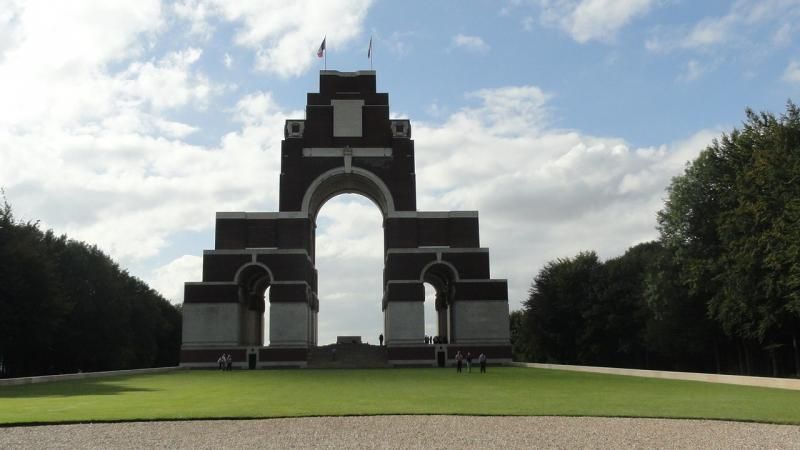
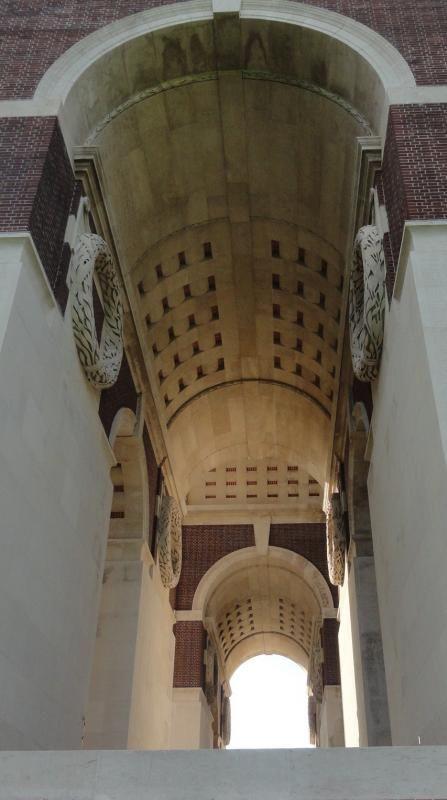
on the interior side of one of the main towers is inscribed
“ Here are recorded names of officers andmen of the British armies who fell on the Somme battlefield July 1915 toFebrurary 1918 but to who the fortune of war denied the know and honouredburial given to their comrades in death”
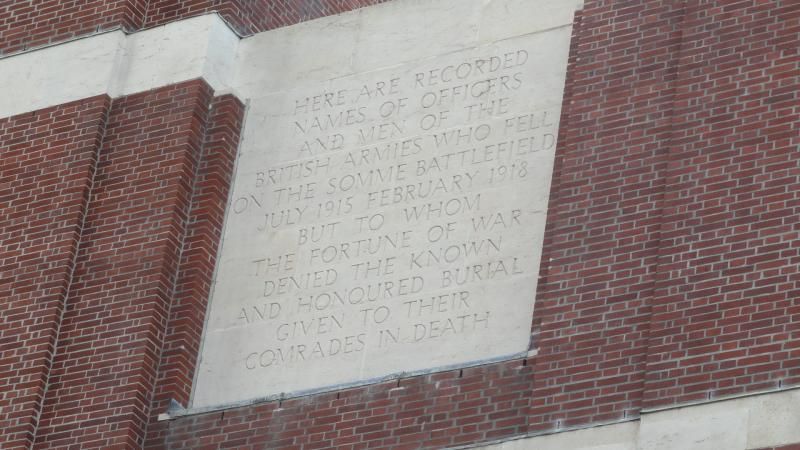
There are 75000 names

In the centre, stands an alter (call it what you will) on which is engraved the verse from Ecclesiastes 44 “Their name Liveth for evermore”
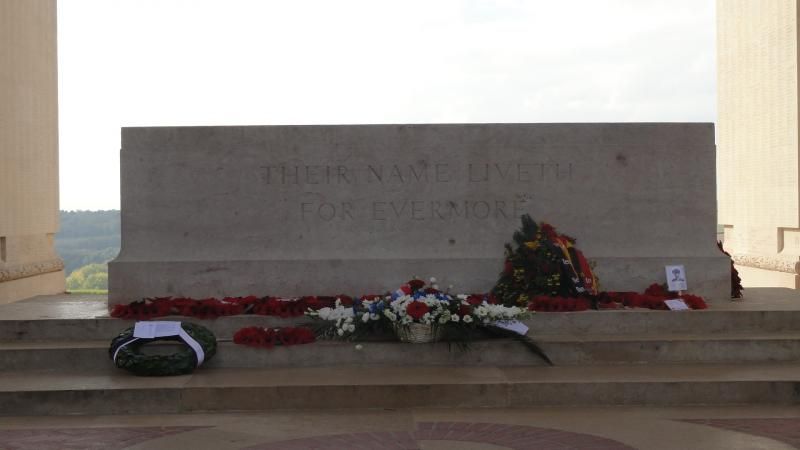
Behind the monument are buried 300 Britsh Soldiers, alongside 300 French.
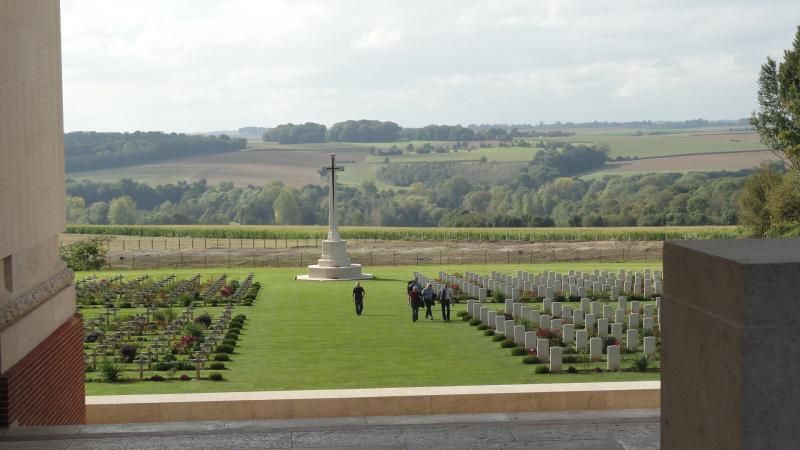
In the walls of the two front pillars are small steel doors which give access to piles of ring binders where the names are noted in alphabetical order, with rank, age, origin & a reference of where to find the name on which face of which pillar.
I found 6 with my surname & 3 with my grandmothers maiden name.
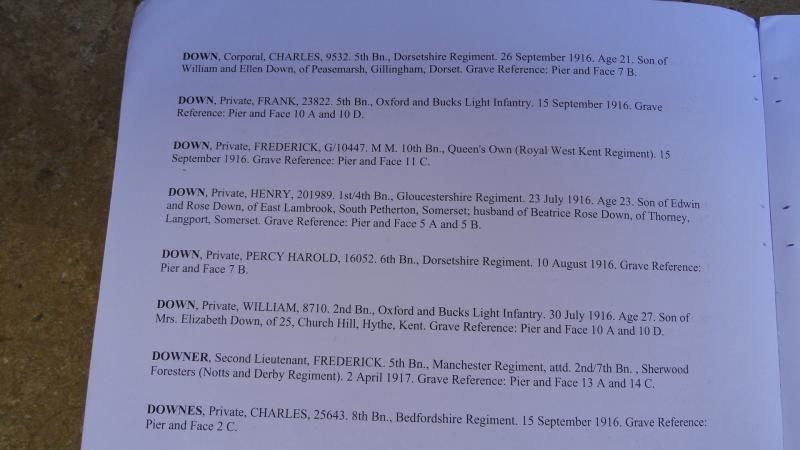
We also spent some time in the visitorcentre here which was quite interesting despite the obligatory “gift shop”which I find a little out of place, bordering on the tasteless...
On to Beaumont Hammell. This is the Canadian monument, more specifically Newfoundland. I wanted to see it as it’s one of the rare places where the entire trench system & battlefield has been preserved. More or less. You can see the trench system & wander round it which is interesting but someone to explain it would be worthwhile. The Caribou monument is obviously a later addition & allows you to look down on the trenches & see where the German positions were in relation (about 250metres away)
At Beaumont Hammel, on the 1 July 1916, the Royal Newfoundland regiment went over the top to attack the German positions. The regiment was reduced from 800 men to 68 in the space of half an hour. The German positions were eventually taken (by the Scottish 51stdivision) on the 13th November.
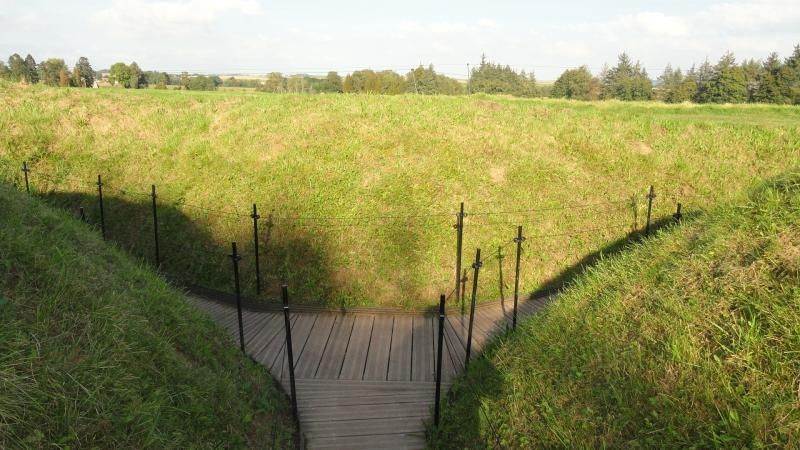
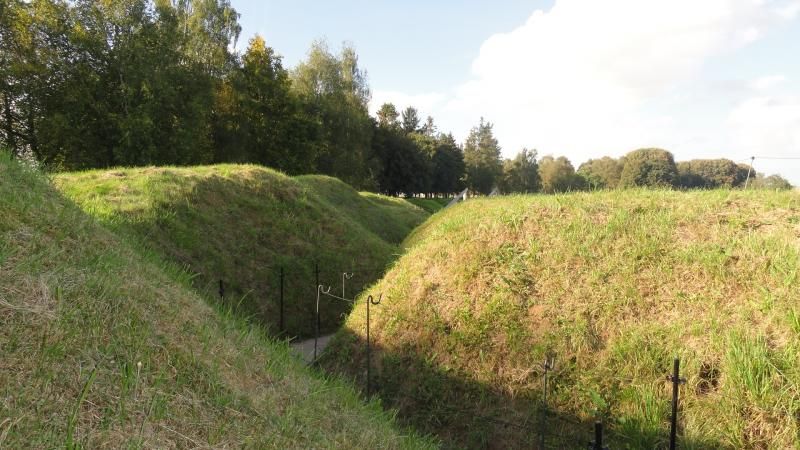
the forward trench was the brown grass line in the forground, the german front line was about where the stone monument is in the background
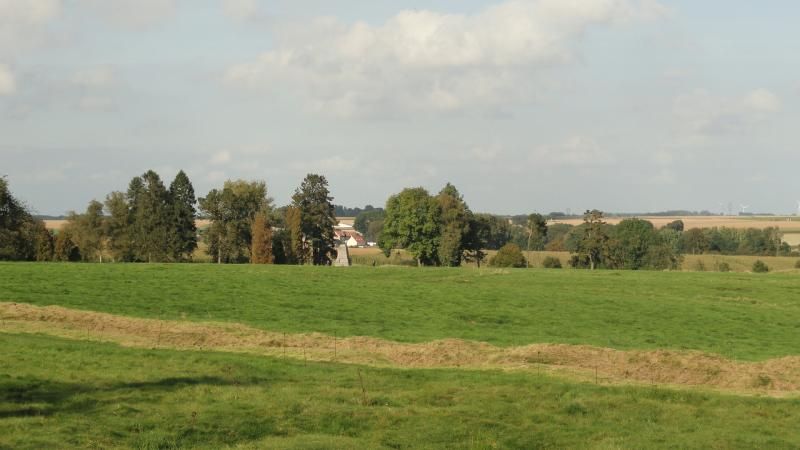

Time was getting on & we had run out of time to do anything else, though there’s plenty more monuments (& literally hundreds of cemetery’s) in the area. Ont he ride back south as far as Compiegne, I made a short detour to Villers Bretonneux. Which is where Australien forces stopped the german advance on Amiens in 1918. There are 10800 names of Anzac soldiers who have no known grave. ( sorry , no pics of this for some reason)
It was in a fairly subdued frame of mind that we rode on to Compiegne for the night. We were almost shell shocked by the sheer numbers of dead. Overall deaths directly imputed to the 14- 18 war are estimated at anywhere between 9 & 15 million,depending on whether you include civilians dying from famine, TB or Spanish Influenza due to living conditions which were caused by the conflict.
I cannot grasp the concept of 9 million, let alone 15.
20 years later we started it again.
friday route
http://goo.gl/maps/2UYb3
sunday morning sky

Sunday was really just the ride home, throughCompiegne forest, as far as Pierrefondswhere I wanted a look at the castle, which is a bit “fairytale”
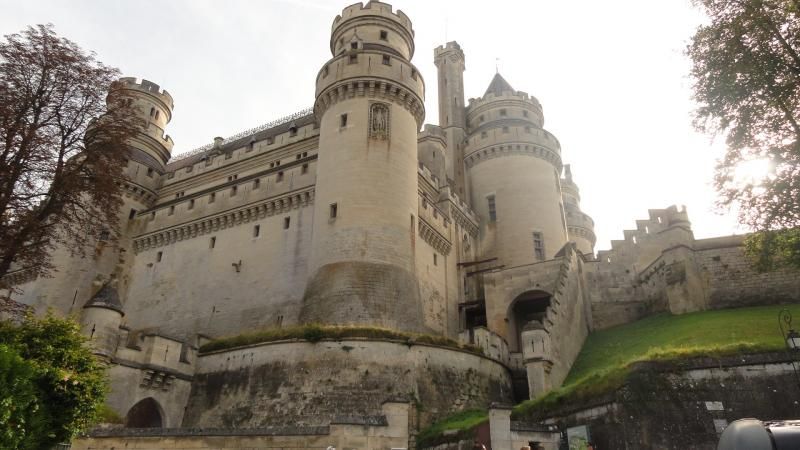
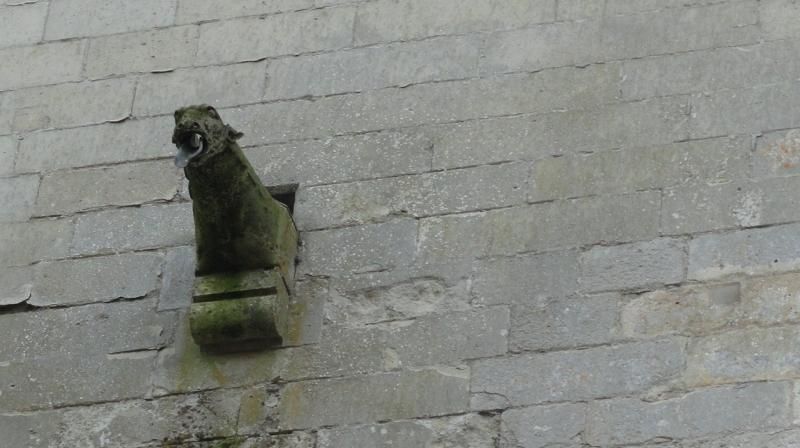
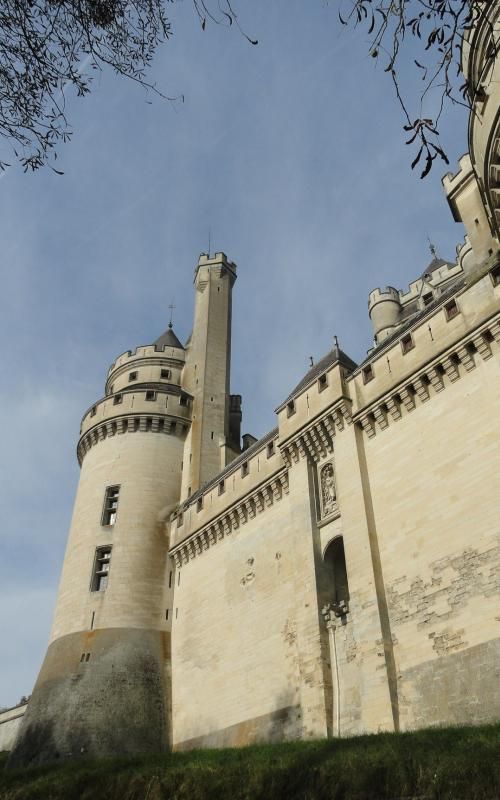
Then back home via meaux, Melun, the A5 south to Sens & along the N6 (D606)Home.
Excellent, if sobering, weekend. Good company, good food & excellent weather.
sunday route
http://goo.gl/maps/GKySF
Where to start ?
I’ll assume you know at least the general outline of the 1st world war & try not to sound like a high school history teacher...
Oneof the major allied offensives of the1st war took place in the Somme region of france in the spring of 1916, many,many soldiers died on both sides. Today there are the cemetery’s and memorials that one can visit, some of the battlefields are still visible 100 years later & there are a couple of museums, in order to explain what happened.
I have wanted for some time to visit some of these sites, partly for the historical interest, partly to pay my respects & partly as some sort of« devoir de memoire » I had the opportunity to grab a couple of days off work so took it & organised a week end trip. The main area of offensive, for British & commonwealth troops was on a 45km front between Peronne, Albert et Bapaume. This is only 300 odd kms from me so an easy afternoon run, but I wanted to have a complete day to visit so I planned to ride up on the Friday, visit on the Saturday & ride home on the Sunday.
Having decided that I didn’t want to do this with a « group of mates » it was either alone or with "A.N.other". A mate of mine (Stephane) was keen to come & able to get away (depite a 3 month old baby at home !)& he rides a knacked out old gpz 500. We also both live in the same world, morally & financially so we understand one another pretty well.
This is how it went...
Steph turned up at mine just before 11 on Friday, skies were clear blue & forcast was good for the whole week end but temps were down to around 13°c so it was liners in & off we went. A quick blast up the autoroute as far as Nemours where we stopped for lunch, & holiday mode was definately kicking in as we both wound down & started to profit from the ride, the sunshine (& the lack of kids...)

After lunch it was time to strip out the liners & hit the route nationale through Fontainebleau forest, Melun & on to Meaux. North of Meaux we got stuck behind a pair of ... I haven’t a clue what they’re called... machines for harvesting beetroot, or possibly sugarbeet? At one point I counted 15 cars, 9 trucks & 3 campervans, + us stuck behind the bloody things! & of course it was just the one section of road that’s narrow a winds around a lake & the "mer de sable" http://www.merdesable.fr/en
I managed to get ridiculously lost around Senlis (I don’t have satnav by the way) I knew I was heading North ish, which was right but i was sure I’d missed the road I wanted & had gone too far west before turning north. For some reason in this part of france the road numbers are not marked on the signposts, I knew I was looking for the town of Estrées but when there was a choice of “Estrées la chapelle” & “estrées summat else” I picked the wrong one...
We stopped further down the line & a quick check of the map soon had us back on course, though rather later than Ihad originally planned. I wish I’d had a go pro for the last bit, from the main road through Cappy & along the Somme valley to the B& B at Curlu... dusk was falling & it was superbly pretty but the road got worse & worse & smaller & smaller & we had to literally lean the bikes into a hedge to let the school bus come through, I swear I could hear Steph cursing the bloody transalp & regretting he’d ever agreed to follow me...
We eventually found the place, showered & had a passable pizza at the restaurant in the village which had a very bizarre billiard table.

friday's route
http://goo.gl/maps/1H5sa
Saturday. Up & breakfast in time to be at the museum in Peronne for 10 ,when it opens. I had no idea how much time we’d want to spend here so we decided to just play it by ear.

It was very good, there is sufficient stuff to occupy an avid history student, but laid out in a way that allows a more casual visitor to just browse through the main exhibits, filtering out the “boring” bits. We lost track of time a spent nearly 2 hours in there.
If "I" means infantry, then this was probably the first "I phone"...

so I had to get a photo of a phone taking a photo of a phone

there is still stuff dug up almost everyday in the area, this lot is awaiting cleaning & classifying...


Lunch in Peronne!
chicken gizzard salad! Yum!

Then on to Rancourt. This was an obvious stop as there are 3 cemetery’s; Brit, German & French.
The brit cemetery here is a smaller one & I planned to visit & couple of larger ones so we visited the French & German ones here. The taking of the village of Rancourt by the French 32nd army corps on 25th September 1916 was decisive, as it marked the rupture of the enemies principal lines of communication. 3223 french soldiers lie here. Across the road are 11422 German.


Interesting way of restraining the flag with a black band, like a sort of permanent "half mast"


We then rode up the D20 to Longueval &“Delville wood” where the South African monument stands.
In Delville wood, 3 batallions of the SouthAfrican infantry (1st brigade I think) fought continuosly for 6 days,took & held the wood. Delville wood was about 1 km Square. On the 14thJuly when The 1st brigade launched their attack on the wood, thebrigade was composed of 123 officers with 3032 NCO’s & soldiers. On the 20thJuly, when they were relieved, there remained 19 officers & 600 men.



From delville wood we rode on to LochnagerCrater at La Boiselle

Despite being a “big hole in the ground”this was almost more moving than the cemeterys, not quite sure why. the thought of the men who dug the tunnels& the conditions they must have worked in? ( read "Birdsong" by Sebastien Faulks) the fact that this “hole” iswhat launched the bloodiest day in the history of the british army? There were3 of these mines, designed to destroy the german wire & front linetrenches. They were set off at 07h27 on the 1st July 1916, at 07h30the whistles blew & the British army went “over the top”...

The high command was sure the mines wouldhave destroyed the German defences, the order was therefore, to “march” forward.The men climbed the trench ladders & formed up into their lines, they thenbegan to advance at walking pace. It is thought that the Germans were aware ofthe attack, had moved their men back until after the mines exploded & thenregained their positions. Whatever the reasons were, they were ready &opened up with machinegun fire “daisycutting” (a steady sweeping crossfire atknee height) from a number of positions. 60,000 men were either dead, injuredor missing by the end of the day.

There is a bench on the edge of the crater on the back of which is noted " donated by friends who visit. In memory of friends who remain"
On to Pozieres, where tanks made their world début, 32 MK1 British tanks took to the battlefield here. 9 of them survived. We didn’t really stop here cos I wanted to get on to Thiepval, so on we went.
The Thiepval monument is impressive & powerful. 16 columns, each column has 4 faces, on each face are engraved the names of the missing from the British & South African armies from 1915 to 1918. “without distinction of rank,religion or social standing”


on the interior side of one of the main towers is inscribed
“ Here are recorded names of officers andmen of the British armies who fell on the Somme battlefield July 1915 toFebrurary 1918 but to who the fortune of war denied the know and honouredburial given to their comrades in death”

There are 75000 names

In the centre, stands an alter (call it what you will) on which is engraved the verse from Ecclesiastes 44 “Their name Liveth for evermore”

Behind the monument are buried 300 Britsh Soldiers, alongside 300 French.

In the walls of the two front pillars are small steel doors which give access to piles of ring binders where the names are noted in alphabetical order, with rank, age, origin & a reference of where to find the name on which face of which pillar.
I found 6 with my surname & 3 with my grandmothers maiden name.

We also spent some time in the visitorcentre here which was quite interesting despite the obligatory “gift shop”which I find a little out of place, bordering on the tasteless...
On to Beaumont Hammell. This is the Canadian monument, more specifically Newfoundland. I wanted to see it as it’s one of the rare places where the entire trench system & battlefield has been preserved. More or less. You can see the trench system & wander round it which is interesting but someone to explain it would be worthwhile. The Caribou monument is obviously a later addition & allows you to look down on the trenches & see where the German positions were in relation (about 250metres away)
At Beaumont Hammel, on the 1 July 1916, the Royal Newfoundland regiment went over the top to attack the German positions. The regiment was reduced from 800 men to 68 in the space of half an hour. The German positions were eventually taken (by the Scottish 51stdivision) on the 13th November.


the forward trench was the brown grass line in the forground, the german front line was about where the stone monument is in the background


Time was getting on & we had run out of time to do anything else, though there’s plenty more monuments (& literally hundreds of cemetery’s) in the area. Ont he ride back south as far as Compiegne, I made a short detour to Villers Bretonneux. Which is where Australien forces stopped the german advance on Amiens in 1918. There are 10800 names of Anzac soldiers who have no known grave. ( sorry , no pics of this for some reason)
It was in a fairly subdued frame of mind that we rode on to Compiegne for the night. We were almost shell shocked by the sheer numbers of dead. Overall deaths directly imputed to the 14- 18 war are estimated at anywhere between 9 & 15 million,depending on whether you include civilians dying from famine, TB or Spanish Influenza due to living conditions which were caused by the conflict.
I cannot grasp the concept of 9 million, let alone 15.
20 years later we started it again.
friday route
http://goo.gl/maps/2UYb3
sunday morning sky

Sunday was really just the ride home, throughCompiegne forest, as far as Pierrefondswhere I wanted a look at the castle, which is a bit “fairytale”



Then back home via meaux, Melun, the A5 south to Sens & along the N6 (D606)Home.
Excellent, if sobering, weekend. Good company, good food & excellent weather.
sunday route
http://goo.gl/maps/GKySF
Last edited:




